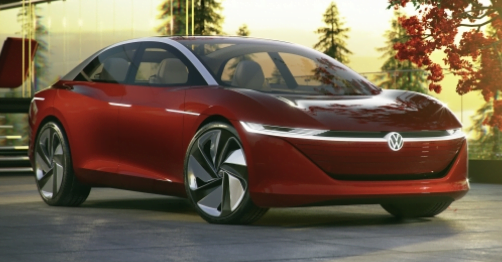At the 2018 Geneva Motor Show, Volkswagen showcased an all-electric concept sedan – I.D. Vizzion – an Artificial Intelligence (AI) powered car that does not require the steering wheel. Though the concept version is still several years away, the automaker did promise a trimmed down production version by 2022.
The Vizzion is the fourth in Volkswagen’s I.D. series besides the I.D. Concept hatchback, I.D. Buzz microbus and I.D. Cross SUV concept. Just like other I.D. concept cars, Vizzion is also a fully electric, all-wheel drive system. What makes it different from others in the family is that the Vizzion concept does not have a steering wheel and pedals.
The car will have Level 5 autonomy, meaning no steering wheel, no pedals, no dashboard and even no dedicated driver seat. Volkswagen’s vision for Vizzion is that a passenger would be able to control the car with voice and gesture alone. To achieve such efficiency, the concept will use radar, sonar, cameras and laser scanners to sense and interpret the surroundings and the road ahead.
In addition, there will be Artificial Intelligence to control the navigation and obstacle avoidance. Further, as the owner spends more time with the car, AI will learn about the surroundings to customize the experience. The car would be aware of the owner – thanks to facial recognition – and thus would customize the seats, lighting, environmental controls and even select your video streaming service. So, all that a passenger would need to do is get into the car and tell it where they want to go.
Volkswagen referred to Vizzion as “it’s most emotional and customized Volkswagen,” adding that when they are not actually driving the car, people want the environment that suits their needs.
Speaking at the Geneva Motor Show, the automaker revealed that the production version of the all-electric Vizzion will hit the road “by 2022 at the latest.” Unlike the concept, it will have a steering wheel and pedals. Further, Volkswagen noted that the capacity of the production car would be similar to the concept, clocking 400 miles on a single charge, powered by 111 kWh. A 75kW motor would power the front wheels, whereas a 150 kW motor would power the rear wheels, offering 300 horsepower to the car.
According to The Verge, the exterior of the car looks like that of a low-riding Lucid Air EV. Volkswagen, however, has added some signature curves to the car. Volkswagen wants to present Vizzion as a car, which in future will be entirely capable of driving itself completely. Thus, the automaker has made a point that new photos include a version of the car with no steering wheel, no pedals and no buttons, notes The Verge.
About the concept, Volkswagen believes that around twelve years from now (by 2030), passengers might get into a fully driverless Vizzion. Vizzion is a part of Volkswagen’s electrification roadmap of putting 50 new electric vehicles on the road by 2025. Just like any other member of the family, Vizzion is also built using the MEB (Modular Electric Matrix) platform, which promises low-cost and longer ranges.
Volkswagen’s design chief, Klaus Bischoff, believes that the car should be seen more as a sneak peek into the future. “Volkswagen is about designing products that are liked by many, many people and this shows where we are going. It has not the function to just create an image for a designer,” Bischoff said, according to Forbes.
“It’s a statement of the company where we are heading. It’s not where we are going. It’s the signpost,” he said. “We could have gone further. It’s our job to lead the people to the way, not to show them the complete thing at the start.”
Volkswagen’s Vizzion concept also hints of the features to expect in other I.D. all-electric family cars. For instance, there will be a smartphone-stored digital key, which the owners will be allowed to share with family and friends. Further, there will be a hologram-based control and infotainment system, which could be operated by gestures. The car is fitted with HD Matrix lights with 8,000 light pixels, and would be able to project symbols onto the road ahead to communicate with pedestrians.
During the Geneva Motor Show, the automaker also presented its Kuka robotics built arm, which according to the company, would help in charging the vehicles while in parking lots. The arm and the charger would support all the vehicles.





